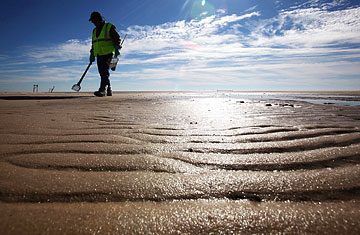
A worker cleans tarballs from the BP oil spill on Waveland Beach in Waveland, Miss., on Dec. 6, 2010. Nearly eight months after the spill, tarballs are still washing up on the beach
(2 of 2)
Bacteria also seem to have taken care of much of the oil that was released in the spill. During July and August, researchers at the Lawrence Berkeley National Laboratory took nearly 200 samples of Gulf water, following the likely dispersal path of the oil, but couldn't find any Macondo crude. While there had been concerns earlier in the summer that large underwater plumes of oil might remain intact, researchers at the Woods Hole Marine Biological Laboratory haven't found much underwater oil since the spill was stopped. And a federal report released in November estimated that at most 22% of the oil spilled into the Gulf might still remain in the waters and that bacteria had likely broken most of that remainder down.
Even if that's true, it doesn't mean the ecological threat posed by the spill has evaporated as well. As bacteria suck oxygen out of the water, they create the risk of anoxic zones — known as dead zones — that threaten sea life. But in the case of methane, at least, Kessler says the highest oxygen-depletion levels he saw were 40%, short of the two-thirds reduction considered dangerous to fish. Still, it's possible that some oil could remain buried in the sediment of the sea floor, where it could disrupt the deep ecosystem. And it's possible too that researchers are simply missing some of the oil and other hydrocarbons as they take samples — the Gulf of Mexico is vast, and scientific resources are finite.
"I would be thrilled if I could sit here and tell you, 'Yeah, the methane is all gone. Isn't that wonderful?' " Samantha Joye, a marine scientist at the University of Georgia, told the Christian Science Monitor. "But 500,000 tons of methane does not get microbially consumed in three months."
As scientists keep examining the Gulf, it may turn out that even if the ecosystem isn't perfect, it's much more resilient than expected. Part of that is not just biochemistry but luck. The relatively warm waters of the Gulf — and the fact that the spill took place more than 40 miles (65 km) out to sea — gave the bacteria the time and environment they needed to consume hydrocarbons. (Alaska's Prince William Sound, by contrast, has no natural oil seeps that would support crude-eating bacteria, so there were none around capable of breaking down oil after the Exxon Valdez spill.) The research done on the Gulf will help scientists develop better bioremediation techniques to clean up the next major spill — because you can't always count on nature to heal itself.
